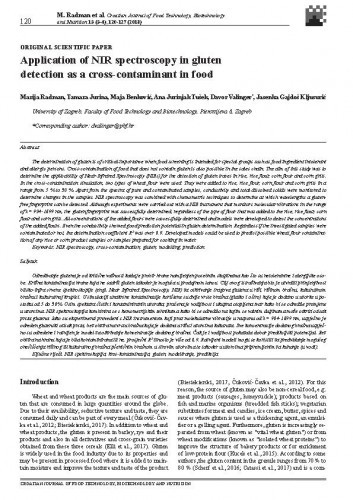The determination of gluten is of critical importance when food screening is intended for special groups such as food ingredient intolerant and allergic persons. Cross-contamination of food that does not contain gluten is also possible in the sales chain. The aim of this study was to determine the applicability of Near-Infrared Spectroscopy (NIRs) for the detection of gluten traces in rice, rice flour, corn flour and corn grits. In the cross-contamination simulation, two types of wheat flour were used. They were added to rice, rice flour, corn flour and corn grits in a range from 5 % to 30 %. Apart from the spectra of pure and contaminated samples, conductivity and total dissolved solids were monitored to determine changes in the samples. NIR spectroscopy was combined with chemometric techniques to determine at which wavelengths a glutenfree fingerprint can be detected. Although experiments were carried out with a NIR instrument that monitors molecular vibrations in the range of λ= 904-1699 nm, the gluten fingerprint was successfully determined, regardless of the type of flour that was added to the rice, rice flour, corn flour and corn grits. All concentrations of the added flours were successfully determined and models were developed to detect the concentrations of the added flours. Even the conductivity showed good prediction potential in gluten determination. Regardless if the investigated samples were contaminated or not, the determination coefficient R2 was over 0.9. Developed models could be used to predict possible wheat flour contamination of any rice or corn product samples or samples prepared for cooking in water.; Određivanje glutena je od kritične važnosti kada je probir hrane namijenjen posebnim skupinama kao što su netolerantne i alergijske osobe. Križna kontaminacija hrane koja ne sadrži gluten također je moguća u prodajnom lancu. Cilj ovog istraživanja bio je utvrditi primjenjivost blisko-infra crvene spektroskopije (engl. Near Infrared Spectroscopy, NIR) za otkrivanje tragova glutena u riži, rižinom brašnu, kukuruznom brašnu i kukuruznoj krupici. U simulaciji unakrsne kontaminacije korištene su dvije vrste brašna (glatko i oštro) koje je dodano u uzorke u postotku od 5 do 30%. Osim spektara čistih i kontaminiranih uzoraka, praćena je vodljivost i ukupna otopljena tvar kako bi se odredile promjene u uzorcima. NIR spektroskopija kombinira se s kemometrijskim tehnikama kako bi se odredilo na kojim se valnim duljinama može otkriti otisak prsta glutena. Iako su eksperimenti provedeni s NIR instrumentom koji prat molekularne vibracije u rasponu od λ= 904-1699 nm, uspješno je određen glutenski otisak prsta, bez obzira na vrstu brašna koja je dodana u rižu i uzorcima kukuruza. Sve koncentracije dodanog brašna uspješno su određene i razvijen je model za otkrivanje koncentracije dodanog brašna. Čak je i vodljivost pokazala dobar predikcijski potencijal. Bez obzira na hranu koja je bila kontaminirana ili ne, prosječni R2 iznosio je više od 0,9. Razvijeni modeli mogu se koristiti za predviđanje mogućeg onečišćenja rižinog ili kukuruznog brašna pšeničnim brašnom u sirovim uzorcima te također u uzorcima pripremljenim za kuhanje (u vodi).
Sažetak
Dio od

 Hrvatski časopis za prehrambenu tehnologiju, biotehnologiju i nutricionizam : Croatian journal of food technology, biotechnology and nutrition : znanstveno- stručni časopis za prehrambenu tehnologiju, biotehnologiju i nutricionizam : 13,3-4(2018) / glavni urednik, editor-in-chief Jadranka Frece.
Hrvatski časopis za prehrambenu tehnologiju, biotehnologiju i nutricionizam : Croatian journal of food technology, biotechnology and nutrition : znanstveno- stručni časopis za prehrambenu tehnologiju, biotehnologiju i nutricionizam : 13,3-4(2018) / glavni urednik, editor-in-chief Jadranka Frece.